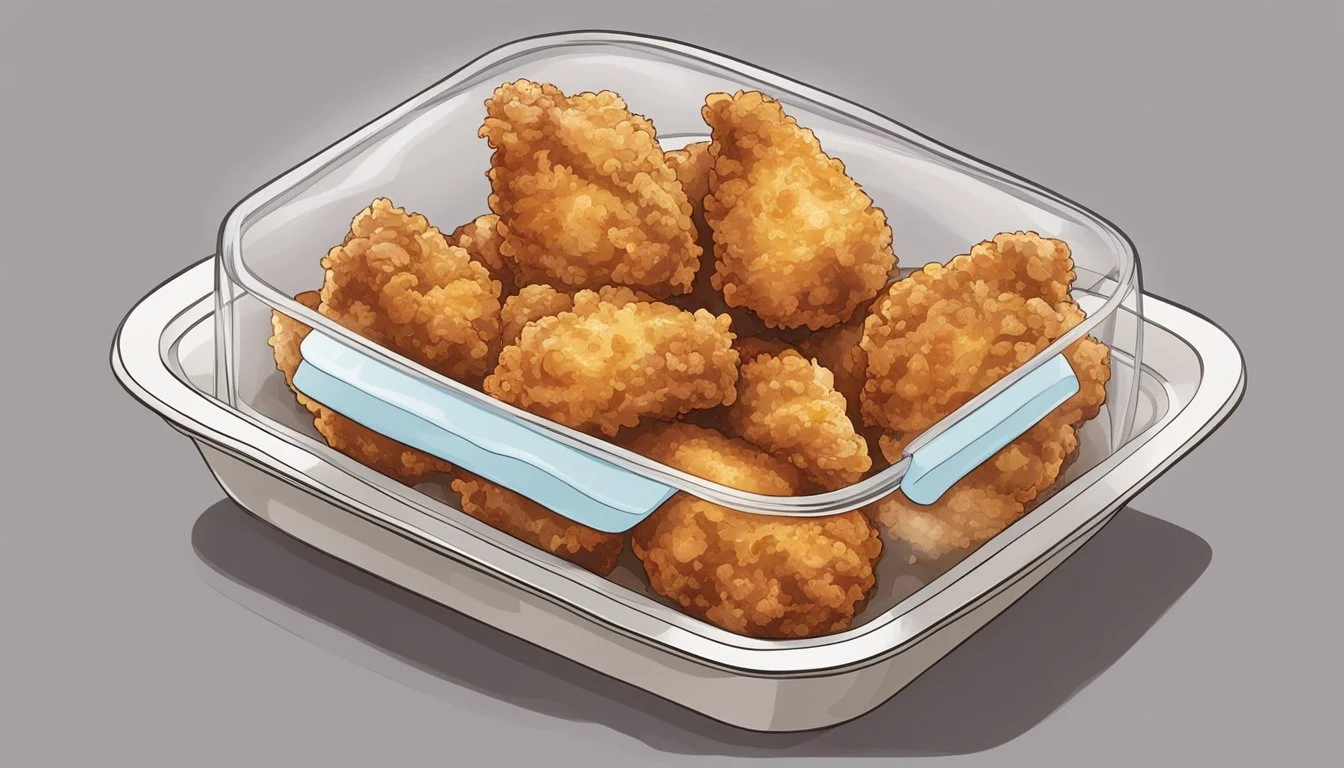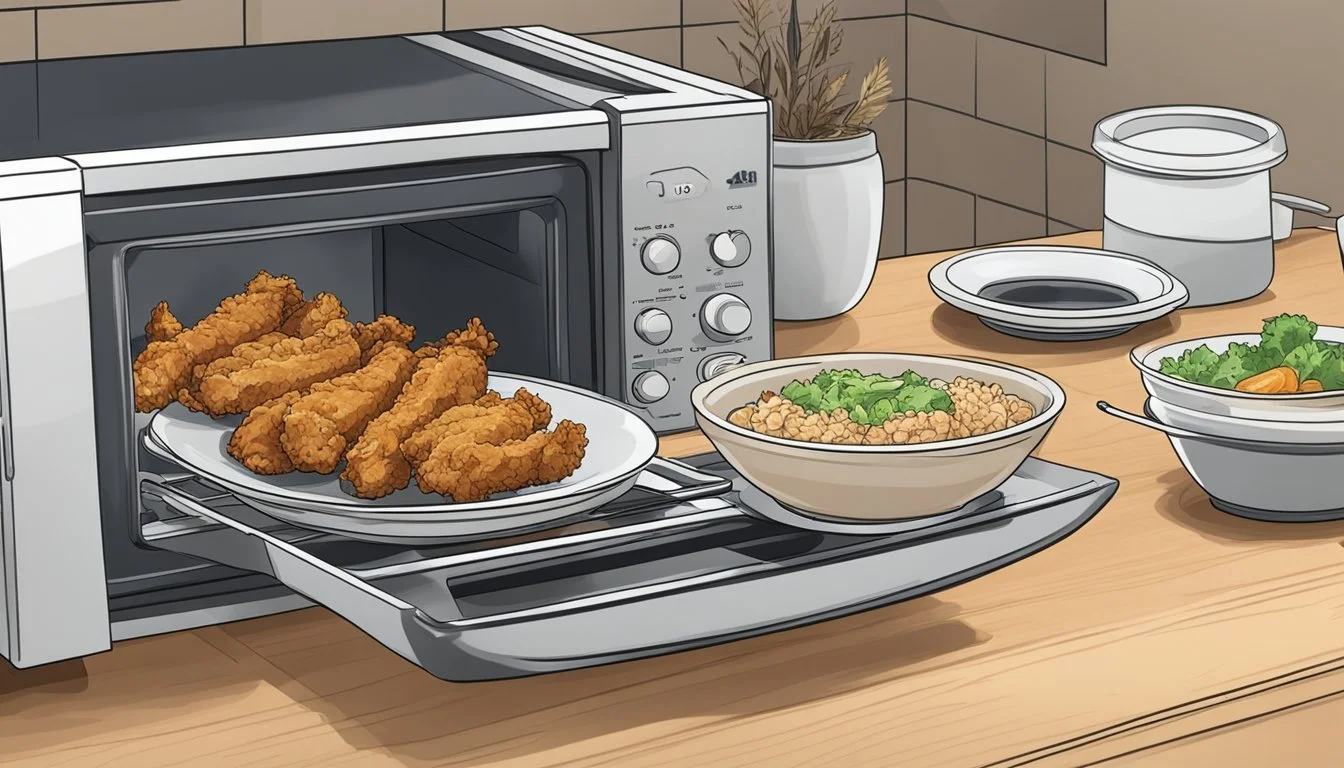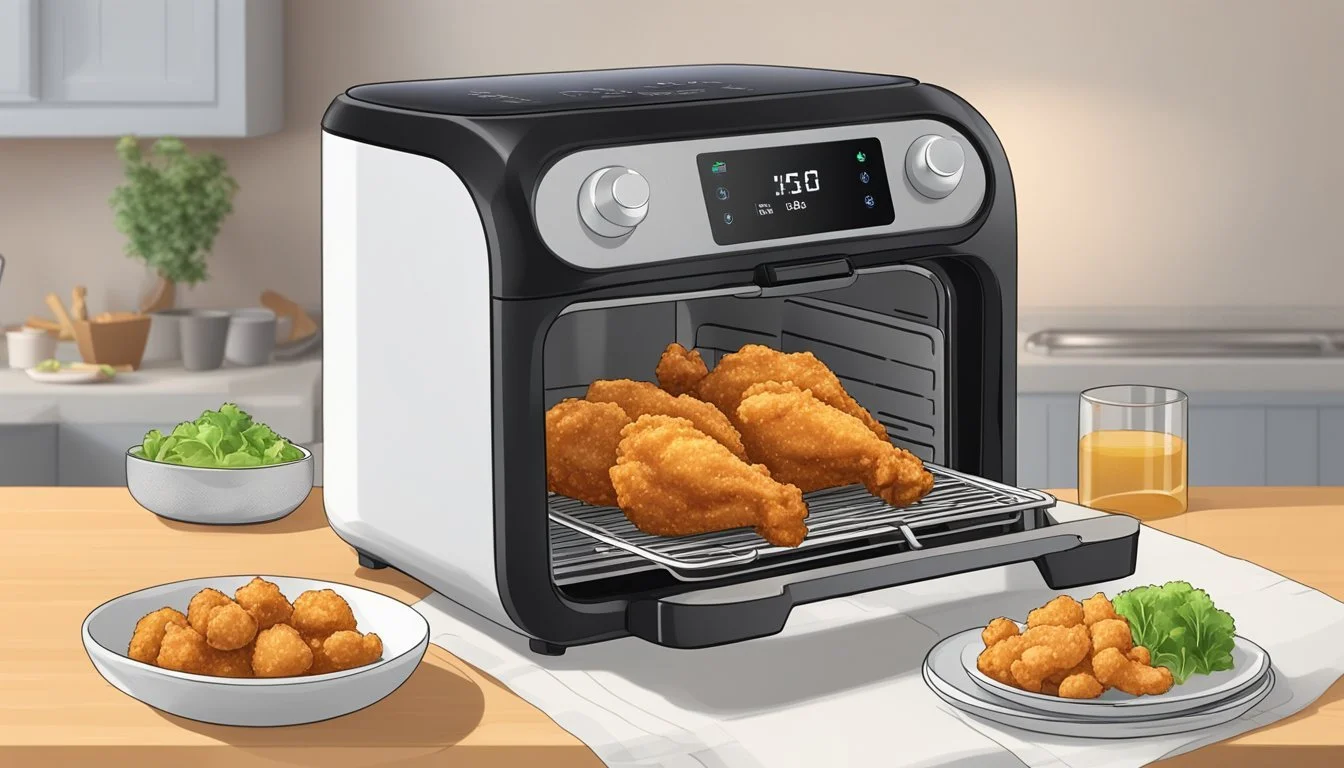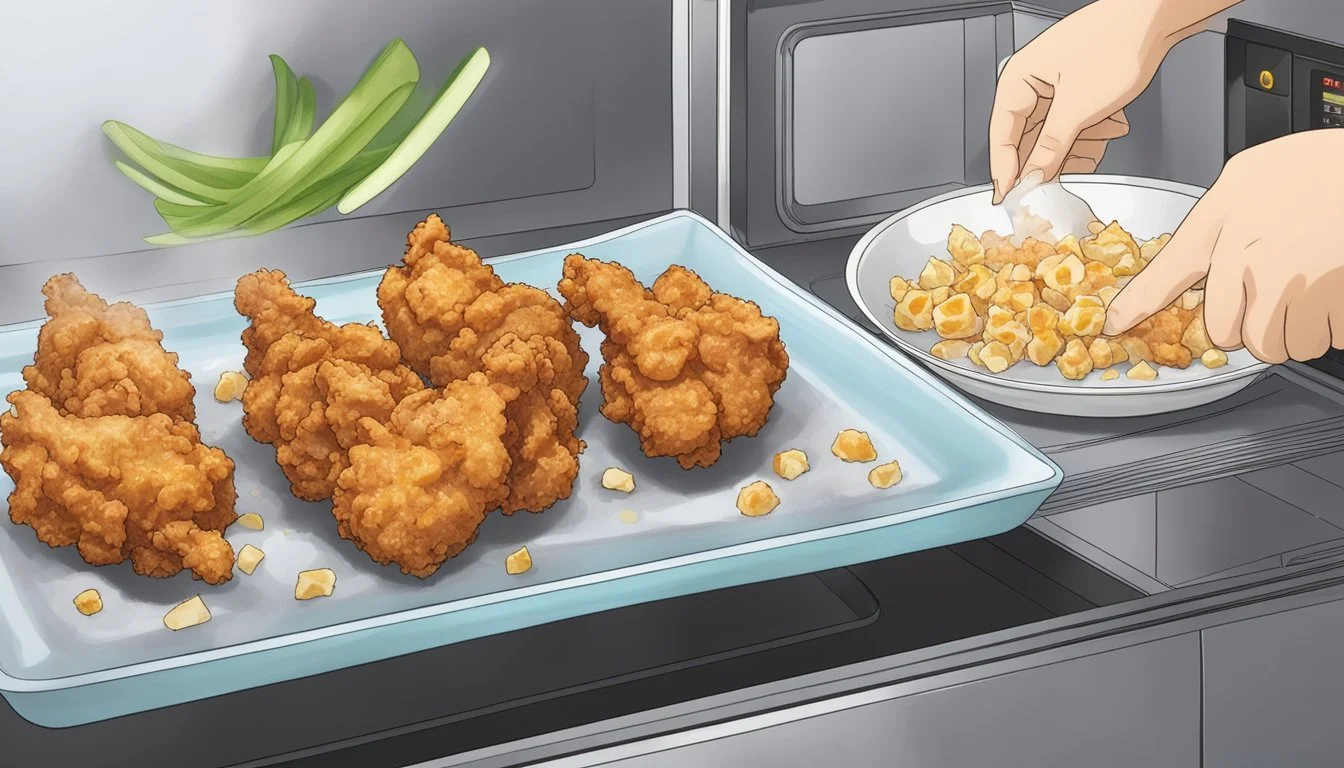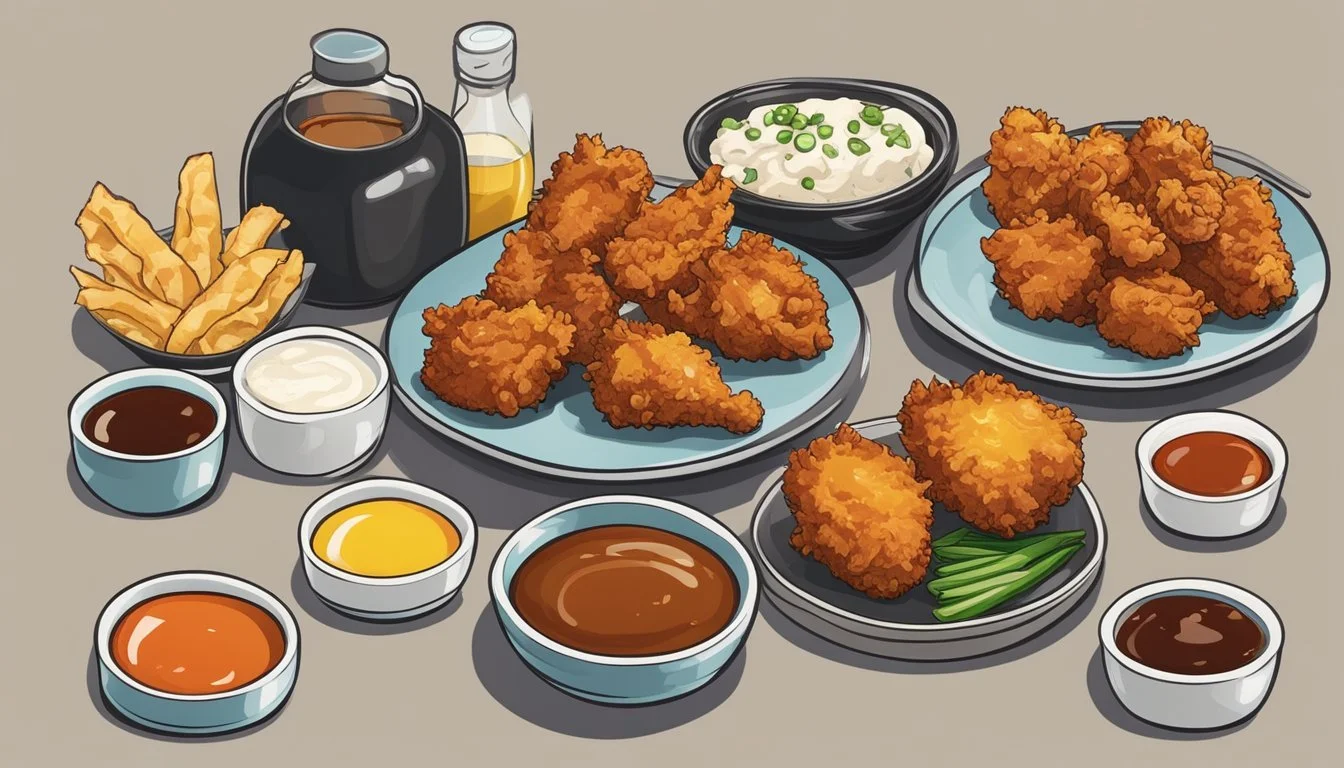How to Reheat Chicken Karaage
Best Methods for Perfect Results
Reheating chicken karaage can be straightforward when approached with the right techniques. This Japanese fried chicken is loved for its crispy exterior and tender interior, and properly reheating it retains these delightful features. The key to reheating chicken karaage is using methods that restore its crispiness without drying it out.
One effective way to reheat chicken karaage is on the stovetop. Using a shallow pool of neutral frying oil heated to medium-high, the chicken can be cooked for 2-3 minutes on each side. This method quickly brings the pieces back to temperature and ensures an even, crispy texture.
Another method is to use the oven. Preheating the oven to 400 degrees Fahrenheit, laying the chicken on a wire rack, and allowing it to come to room temperature before heating for 10-15 minutes can yield great results. This technique helps in retaining the crispy exterior while thoroughly warming the inside.
Understanding Chicken Karaage
Chicken Karaage, a popular Japanese dish, consists of Japanese-style fried chicken known for its savory and slightly sweet flavor.
These bite-sized pieces of boneless chicken thigh are marinated to enhance flavor.
The marinade usually includes soy sauce, ginger, sake, garlic, and sugar.
The marinade process typically lasts at least one hour, but for the best results, it's recommended to marinate overnight.
Once marinated, chicken pieces are dredged in a mixture of flours. A traditional combination might include all-purpose flour and potato starch.
This coating contributes to the signature crispiness when the chicken is fried.
The chicken is then fried until golden brown. This double frying process ensures a crispy exterior while keeping the inside tender and juicy.
Chicken Karaage can be served as a main dish, appetizer, or even a snack.
It pairs well with various dipping sauces and can be served on a bed of rice, making it a versatile addition to many Japanese recipes.
Its popularity stems from its unique blend of flavors and texture, striking a balance between savory and sweet.
Its preparation method and ingredients help differentiate it from other types of fried chicken.
Initial Preparation Tips
Marinate Thoroughly: Chicken karaage benefits from a flavorful marinade. Combine chicken thighs with cooking sake, soy sauce, grated ginger, and a touch of sugar. Tip: Adding sesame oil can enhance the flavor. Let the chicken marinate in the fridge for at least 1 hour, or ideally overnight.
Use Skin-On Pieces: For maximum juiciness and texture, choose chicken thighs with the skin on. Skin provides additional moisture and helps retain the crunchiness during reheating.
Light Coating of Flour: Before cooking, lightly coat the marinated chicken in flour. This helps achieve a crunchy outer layer. Tip: Use a mix of flour and cornstarch for extra crispiness.
Maintain the Crunch: When ready to reheat, ensure the chicken is at room temperature. This helps in even reheating and keeps the exterior crunchy. Place the chicken on a wire rack to prevent it from becoming soggy.
Gentle Handling: Flip chicken gently using tongs to avoid breaking the crunchy crust. This ensures an even texture without losing the crispiness.
Minimal Moisture: Avoid adding too much liquid during reheating. A small amount of water or oil is sufficient to maintain the juiciness without compromising the crunchy exterior.
Optimal Storage Methods
Proper storage is crucial to maintain the quality and safety of leftover chicken karaage. Start by letting the chicken cool to room temperature.
When storing, use airtight containers or zip-top bags. If possible, opt for containers to prevent the chicken from getting squished. Separating pieces with parchment paper can help preserve the crispy exterior.
Aluminum foil can also be used for wrapping chicken, but it is best as an additional layer for sealing containers. This helps in retaining moisture while preventing the absorption of other odors in the fridge.
Storage Instructions:
Step 1: Cool the chicken completely.
Step 2: Transfer to airtight containers or zip-top bags.
Step 3: Optionally, wrap with aluminum foil for added protection.
Refrigerate the stored chicken at 40°F (4°C) or lower. For longer storage, they may freeze the chicken. Ensure it is well-separated to maintain the crispiness.
Freezing: For optimal quality up to three months, place the chicken in freezer-safe bags. When ready to reheat, thaw in the refrigerator overnight.
Reheating Methods Overview
Reheating chicken karaage properly ensures that it retains its crispy texture and delicious flavors. The following methods provide a variety of options depending on the tools and time available.
Using an Oven
Preheat the oven to 375°F (190°C).
Place the chicken karaage on a baking sheet lined with aluminum foil. Arrange the pieces in a single layer to ensure even heating. Cover the chicken lightly with aluminum foil to prevent it from drying out.
Bake for 10-15 minutes, checking halfway through to ensure the chicken is reheating evenly. For extra crispiness, remove the foil during the last 3-5 minutes.
Notes:
Pros: Retains crispiness and heats evenly.
Cons: Takes longer than other methods.
Utilizing an Air Fryer
Preheat the air fryer to 350°F (175°C).
Place the chicken karaage in the air fryer basket, ensuring pieces do not overlap. Cook for 5-7 minutes, shaking the basket halfway through for even cooking.
Benefits:
Pros: Quick and maintains crisp texture.
Cons: Can only reheat small batches at a time.
Skillet Reheating Technique
Heat a skillet over medium heat and add a small amount of oil.
Place the chicken karaage in the skillet and cover with a lid to trap heat. Reheat for about 5-8 minutes, turning pieces occasionally to ensure they crisp up evenly.
Important Tips:
Pros: Quickly re-crisps the chicken.
Cons: Requires constant attention to avoid burning.
Microwave Method
Place chicken karaage on a microwave-safe plate lined with a paper towel.
Cover with another paper towel and microwave on medium heat for 1-2 minutes. Check frequently to avoid overcooking.
Considerations:
Pros: Fast and convenient.
Cons: May not stay as crisp.
Double Frying Method
Heat oil in a deep pan to 350°F (175°C).
Dip the chicken pieces back into hot oil for 2-3 minutes. This refreshes the crunchiness and ensures the chicken is hot all the way through.
Key Points:
Pros: Restores original crispiness.
Cons: Messy and adds more oil.
Oven Reheating Guide
To reheat chicken karaage in the oven effectively, start by preheating the oven to 350°F (175°C).
Place a baking sheet on a middle rack to heat up as the oven preheats.
Once preheated, arrange the chicken karaage on the heated baking sheet. Spread the pieces out evenly, ensuring they do not touch. This spacing helps maintain a crispy exterior.
Cover the chicken lightly with foil to prevent them from drying out during initial heating. Reheat for about 15 minutes.
After 15 minutes, remove the foil. Continue baking uncovered for an additional 5-10 minutes. This step restores the crunchy texture.
Check that the internal temperature of the chicken reaches 165°F (74°C) using a thermometer. This ensures safe reheating, especially with boneless chicken thighs.
For extra crispiness, broil the chicken on high for a minute or two at the end.
Using these steps secures well-reheated chicken karaage with a crispy exterior while keeping the inside moist and delicious.
Air Fryer Reheating Steps
Reheating chicken karaage in an air fryer keeps it crunchy and full of flavor.
To start, preheat the air fryer to 365°F. This temperature is optimal for maintaining the texture of the chicken.
Next, lightly spray the air fryer basket with a bit of canola oil. This helps in preventing the chicken from sticking and adds a touch of crispiness.
Place the chicken karaage pieces in the air fryer basket. Make sure they're not overcrowded to promote even reheating.
Reheat the chicken for about 5-6 minutes. Check one piece to ensure it's sufficiently warm, with a nice, crunchy exterior.
If the chicken pieces are larger, like chicken thighs, you may need to extend the reheating time by a couple of minutes.
Don't forget to flip the chicken halfway through the reheating process. This allows both sides to get equally crispy.
Using an air fryer for reheating is a practical way to enjoy leftover chicken karaage with its original texture preserved. This method is efficient and ensures your chicken is ready quickly, retaining its delectable crispy bite.
Stovetop Skillet Instructions
To reheat chicken karaage on a stove, using a skillet is a convenient and effective method. This way preserves the crispy exterior of the chicken.
Ingredients:
Leftover chicken karaage
Vegetable oil (or alternative oil like canola or peanut oil)
Instructions:
Preheat the Skillet: Place a skillet on the stove over medium heat. Let it preheat for about 1-2 minutes.
Add Oil: Pour a small amount of vegetable oil into the skillet, just enough to coat the bottom. Heat the oil until it is hot but not smoking.
Test the Oil: To ensure the oil is ready, drop a small amount of water into the skillet. If it spatters lively, it's ready for the chicken.
Reheat Chicken: Carefully place the chicken karaage in the skillet using tongs or a spatula. Avoid overcrowding the skillet to maintain the crispy exterior.
Cook Time: Heat the chicken pieces for 3-4 minutes on each side or until they are evenly warmed through. The exterior should become crispy again.
Check Temperature: Ensure the internal temperature of the chicken reaches at least 165°F (74°C) for safe consumption.
Tips:
For even reheating, occasionally move and flip the chicken pieces.
Use a non-stick skillet to prevent sticking and aid in easy cleanup.
Microwave Turnover Skills
Reheating chicken karaage in a microwave can be quick and effective.
To start, place the leftover karaage on a microwave-safe plate in a single layer.
Cover the plate with a microwave-safe lid or wrap. Leaving a corner vented ensures steam can escape.
Microwave the karaage on high for 2-3 minutes per piece.
Flip each piece halfway through the reheating time to ensure even heating.
Checking temperature is crucial. Use a meat thermometer to ensure the internal temperature reaches 165°F.
For better texture, place a moist paper towel over the chicken before reheating. This helps retain moisture and prevents drying out.
If you notice the karaage is still cold in the center, reheat in 30-second increments, flipping after each interval.
Avoid overcrowding the plate. Space each piece apart to allow even heating.
With proper microwave turnover skills, your chicken karaage will be evenly heated and ready to enjoy.
Creative Serving Suggestions
Chicken karaage offers a versatile foundation for various dishes. Here are some ideas to elevate your meal:
Bowls and Plates:
Serve chicken karaage atop a steaming bowl of rice or as part of a colorful teriyaki chicken bowl. Add a side of miso soup or a light vinegary cucumber salad for balance.
Sandwiches:
Transform chicken karaage into a satisfying sandwich. Place the crispy bites between two slices of bread, add Kewpie mayo, fresh greens, and thinly sliced shallots. The combination of textures and flavors makes for a delightful meal.
Fusion Dishes:
Create a unique twist on pizza. Use chicken karaage as a topping along with teriyaki sauce, thinly sliced seaweed, and a sprinkle of sesame seeds. The fusion of Japanese and Italian flavors offers a refreshing change.
Appetizers and Snacks:
Offer chicken karaage as an appetizer with various dipping sauces such as spicy mayo, soy sauce mixed with lemon juice, or a tangy vinegar-based sauce. These options cater to different palates and enhance the chicken's flavor.
Main Courses:
Incorporate chicken karaage into a larger meal by pairing it with rotisserie chicken or yakitori. This adds diversity to a weeknight dinner and ensures a satisfying spread. Add some korean fried chicken for those who enjoy bolder flavors.
By using these suggestions, chicken karaage can be integrated into numerous dishes, making it a versatile option for various meals.
Pairing With Condiments
When reheating chicken karaage, pairing it with the right condiments enhances its flavor. Togarashi, a Japanese spice blend, adds a subtle heat and complexity. Sprinkling sesame seeds not only boosts the flavor but also provides a pleasant crunch.
Salt and pepper are classic choices, bringing out the savory and umami notes of the chicken. A pinch of salt emphasizes the umami flavor, while pepper adds a mild kick.
For dipping sauces, options abound:
Ponzu Sauce: A citrus-based soy sauce, perfect for a tangy twist.
Yuzu Mayo: Combines yuzu zest with mayonnaise for a creamy, citrus tang.
Gochujang Sauce: Adds a spicy and sweet flavor profile.
Adding a side of miso soup complements the chicken karaage well, balancing the dish with a warm and savory broth.
Using sesame oil as a light drizzle can infuse a nutty aroma, enhancing the overall taste experience.
These condiments and sides ensure that reheated chicken karaage maintains its delicious appeal while offering varied flavor profiles.
Savory Side Dishes
Chicken karaage pairs wonderfully with a variety of savory side dishes. These side dishes not only complement the flavors but also provide a balanced meal.
Rice: Steaming hot rice, such as jasmine or short-grain sushi rice, is an excellent accompaniment. The fluffy grains soak up the rich flavors from the chicken, creating a harmonious bite.
Salads: A crisp green salad with a light sesame dressing adds freshness to the meal. The crunchy vegetables contrast nicely with the crispy karaage and bring a vibrant, healthy aspect to the plate.
Main Course Additions: Including a bowl of miso soup can enhance the dining experience. Its light broth, enriched with savory miso paste and garnished with tofu, seaweed, and green onions, provides a comforting side.
Potato Starch-based Dishes: Potato starch is commonly used in Japanese cuisine for its crisp texture. Consider serving Japanese potato salad made with mashed potatoes, cucumber, and carrot, which adds a creamy texture that pairs well with the fried chicken.
Seaweed: Nori seaweed or seaweed salad can provide a slightly salty and umami-rich addition. These flavors complement the savory taste of chicken karaage.
Sesame Seeds: Sprinkling toasted sesame seeds over rice or salads can add a nutty flavor and a bit of crunch. They enhance both the taste and presentation of the dish.
Mix and match these side dishes to create a flavorful and balanced meal that highlights the deliciousness of chicken karaage.
Advanced Techniques: Double Frying
Double frying is an effective method to reheat chicken karaage while maintaining its crispy texture. This technique involves frying the chicken pieces twice at different temperatures.
Start by heating the oil to a lower temperature, around 325°F (163°C). Fry the chicken pieces for about 4-5 minutes. This step ensures the interior is cooked through.
Next, remove the chicken from the oil and let it rest for a few minutes. This brief pause helps redistribute the juices within the chicken, making it more flavorful and juicy.
After resting, increase the oil temperature to 350°F (177°C). Fry the chicken pieces again, this time for a shorter duration: 2-3 minutes. This step creates a crispy exterior while maintaining the juicy interior.
Key Points:
Use a deep frying method with enough oil to submerge the chicken pieces.
Ensure consistent oil temperatures for each frying step.
Avoid overcrowding the pan to maintain the oil temperature and achieve even frying.
Double frying not only reheats the chicken karaage but also enhances its crispy, flavorful texture.
Health and Safety Tips
When reheating chicken karaage, adhering to food safety guidelines is crucial.
Storage Guidelines: Store leftover chicken karaage promptly in airtight containers. Refrigerate at temperatures below 40°F (4°C) within two hours to prevent bacterial growth. Use or freeze leftovers within three to four days for optimal quality and safety.
Cooking Temperature: Always reheat chicken karaage to an internal temperature of 165°F (74°C). Use a food thermometer to check the temperature. This ensures that any bacteria present are effectively killed, reducing the risk of foodborne illness.
Oils: When reheating on the stovetop, use oils with a high smoke point like canola oil. This prevents the oil from breaking down and producing harmful compounds. Heat the oil until shimmering before adding the chicken to maintain its crispy texture.
Safe Handling: Avoid cross-contamination. Use clean utensils and surfaces when handling reheated chicken. Always wash hands thoroughly before and after handling food to ensure hygiene.
Microwave Tips: When using a microwave, add a small amount of water or broth to keep the chicken moist. Cover with a microwave-safe lid or plastic wrap, leaving a small opening for steam to escape. Heat in short intervals and check the temperature often.
By following these health and safety tips, you can enjoy reheated chicken karaage confidently and safely.

